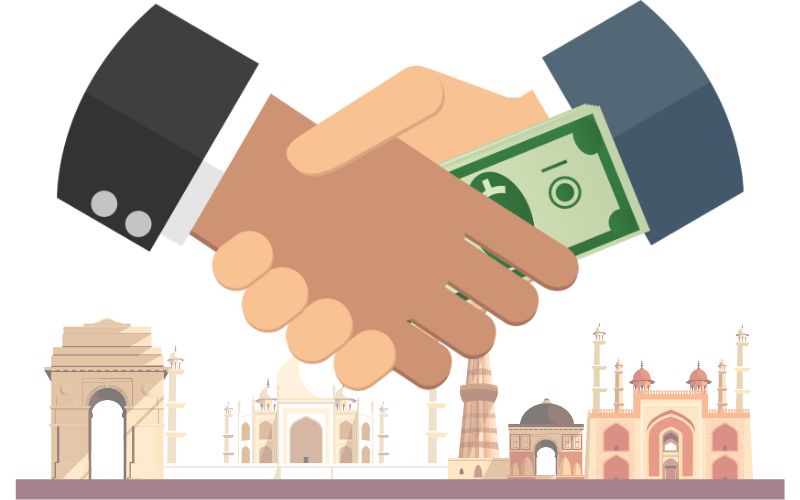Fall of a Giant: India’s Shadow Economy

This blog post has been authored by Manish Vaidya, Economics Researcher at Arthashastra Intelligence
What is Shadow Economy?
Shadow, Informal or Black economy consists of all the economic activities that are not accounted for in the GDP and are deemed illicit. This economy survives alongside the formal economy. In other words, market-based production of goods and services escapes calculation in the official GDP figures.
These activities fall outside of the purview of the country’s rules and regulations pertaining to commerce and trade.
Elements of Shadow Economy
Payments made “under the table”, derivative investments like participatory notes, the Hawala system, Unaccounted donations to SHGs and NGOs, Transferring profits to tax havens, and many more unusual and smart tactics are the founding pillars of the black economy.
Shadow or underground economic activities can be broadly categorized into two types.
Illegal Activities, like trade with stolen goods, for instance, the infamous “Chor-bazaars in India”, prostitution, gambling, drug & human trafficking, smuggling, etc. These activities can be both monetary and non-monetary in nature.
Legal activities, insider income through unreported self-employment, wages & assets from unaccounted and unreported work that is economic in nature. Tax evasion and tax avoidance under the banner of fringe benefits, etc can also be included.
It has been noted that the rise in government intervention since the 1970s, which is associated with a rise in taxes and government regulations to finance the increasing public spending, are a few vital building factors that have led to the propagation and growth of the underground economy. There are various obvious negative effects of such shadow economies. Increased inefficiency, labor market failure, unfair competition, loss of governance, the emergence of a thriving parallel economy, migration of labor to the informal sector from the official sector, human and worker rights issues, widening income and wage disparities, and disturbance in the tax-expenditure cycle are a few of the most visible and hampering effects. The existence of shadow economies introduces a huge glut and brings about lags and hindrances in economic policies. On the positive, research has shown that some of the income obtained in the informal economy is spent in the official economy and hence there is a positive net effect.
Source: World Bank; Compilation and Visualization By Arthashastra Intelligence.
Measurement of the Shadow Economy
There is no clear consensus or an analytical framework to measure or estimate the shadow economy. A few approaches adopted over the years by various researchers are usually through Fiscal, Monetary, Physical input, Labor market, and national income routes.
India’s State
Various governments have taken the issue to light. The Venkatappiah Committee, 1974, and Dagli Committee Report, 1979 put forward that increasing regulations and broadening tax regimes are the parallels of the gray economy. Corruption and inefficiencies are the operative pillars of the shadow economy. Construction, real estate, mining, and higher education are the main sectors constituting the black economy.
India’s informal sector has been estimated to be 65% of the GNP. The shadow economy erases the tax base and creates a vicious cycle of tax erosion and budget deficits. This invites higher tax rates which further expands the shadow economy and weakens output- a consequence of fiscal tightening. High taxes, weak rule of law, high bribery, and corruption is the perfect cycle of a non-optimal equilibrium and resultant shadow economy. However, assessing from a wider perspective, the shadow economy has actually shrunk in the past decade(Fig 1). A report by SBI posited that India’s shadow economy shrunk to 15-20% in 2020, from around 52% in 2017-18. The government’s push to widen the spans of digitization through various measures has played off well. Kisaan Credit Scheme, the Use of digital payments, reduced cash intensity, and GST reforms that somewhat aid the formalization of various entities have resulted in the dampening of the shadow economy.
This trend must continue, while there are both negatives and a few positives of the shadow economy, the situation of being stuck in the viscous tax-budget deficit cycle is undesirable and unhealthy for any economy.
References:
- Retrieved from The National News (Author: Rebecca Bundhun) India’s underground economy
- Retrieved from Live Mint (Author: Satya Mohanty) Politicians must bite the bullet to shrink our shadow economy
- Retrieved from The Print (Author: Ila Patnaik and Radhika Pandey) How India’s informal economy is shrinking, and why that’s good news in the long term
- Menon, P., 2019. The rise of the shadow economy: An Indian perspective. Journal of Public Affairs, 19(1), p.e1880.
Chaudhuri, K., Schneider, F., and Chattopadhyay, S., 2006. The size and development of the shadow economy: An empirical investigation from states of India. Journal of Development Economics, 80(2), pp.428-443.
